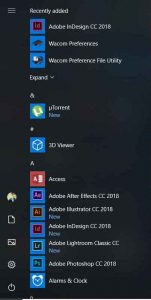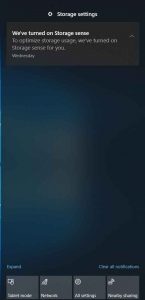Start Menu, Action Center and Taskbar
The Start menu, taskbar and Action Center are likely to be three of the most used areas of the Windows 10 interface for most people. There have been several additions and improvements to these tools in the recent Anniversary update, making them even easier and more intuitive to use, so let’s take a look at what you can do with these essential Windows tools.
All Apps List

As you use Windows 10 and the various apps and software, a list of your most used tools will appear here. This is constantly updated as your use of the OS evolves. At the top of the All Apps list is a Recently Added section, showing newly installed software and a Most Used section showing your favorite applications. Click either heading to open a jump to letter menu.
System Folders

You can change the folders that appear in the bottom half of the Start menu, depending on how you use Windows 10. Settings, Power and All Apps will always be present in this part of the menu but everything else can be chosen in Settings > Personalisation.
Search Bar
![]()
The search bar is always visible to the right of the Windows button, unless viewing an app or game in full screen mode. Click in the Ask me Anything box and the search window will open. You can either type your search term or, if set up, use the Mic to ask Cortana. When the search menu opens, it will hopefully be prefilled with relevant information and links.
Start Menu Tiles

Just as with Windows 8.1, the tiles that appear in the Start menu display information (when appropriate) from the apps and services they link to. You can customize the look of the tiles by right-clicking on them and selecting an option from the menu that appears. Tiles are now automatically split into relevant sections, e.g. Play and Explore.
Action Center Notification

Notifications in the Action Center range from security alerts and system errors, to emails and Facebook updates. If you are seeing notifications here that you don’t need, Twitter updates for example, you can right-click the heading and turn off notifications for that app.
Quick Settings

The Quick Settings displayed here will vary depending on the device you are using. You will normally see Wi-Fi, Note, All Settings, Bluetooth, Location and Quiet Hours here at the very least. If the Quick Settings menu is collapsed, click the Expand button to show the full menu. You can now customize the quick settings buttons shown in Settings > System > Notifications and Actions.
Taskbar
![]()
The taskbar contains shortcuts to many of the most commonly used apps, including the Edge browser, App Store and File Explorer. You can add any app to the taskbar by right-clicking on the tile or app icon and selecting Pin to taskbar from the menu. Right-clicking on the taskbar will also allow you to add different toolbars to it
The right-hand side of the taskbar contains several essential Windows tools. Here you can check battery power (if using a laptop), your Wi-Fi connection details, speaker volume and several other things. You will also find the button to open the new Action Center here. The Anniversary update added notification badges here, so you can see unread notification amounts at a glance.
Start